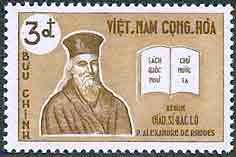

A PUBLICATION OF CLASS COM 492 AT CONCORDIA UNIVERSITY IRVINE - SPRING 2010 SECOND EDITION

The image of Fr. Alexandre de Rhodes on a South Vietnamese stamp
The Jesuit Who Scripted A Very Difficult Language
Some 80 million people worldwide speak Vietnamese. Like Chinese, it is a multi-pitched “tonal language.” Since the 13th century, the Vietnamese wrote in a script based on Chinese characters. The French Jesuit missionary Alexandre de Rhodes (1591-1660), who authored the first Vietnamese Catechism, developed a writing system based on the Latin alphabet. It is called Chữ Quốc Ngữ (script of national language). It employs the 26-letter Latin system minus the consonants f, j, w and z. In the early 20th century, the French colonial administration made de Rhodes’ alphabet official.
Chữ Quốc Ngữ features nine diacritical marks, or accents, indicating different ways of pronouncing a letter. Seven modified letters are considered their own letter in the Vietnamese alphabet; for example, the alphabet begins with A (no mark) and continues with, Ă and Â. Each of the three has a different pitch.
Depending on the marks, the combination of the same consonants and vowels can mean very different things. Accents can for instance change the sense of the Vietnamese word “hoa” from “flower” to “peaceful,” “fire,” “painting” or “home.” The diacritics make it necessary to read an entire Vietnamese sentence to understand its content. EMILY WATSON